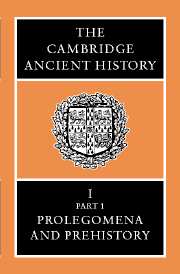Book contents
- Frontmatter
- Contents
- List of Maps
- List of Tables
- List of Text-figures
- Preface
- Chapter I The Geological Ages
- Chapter II Physical Conditions in Eastern Europe, Western Asia and Egypt Before the Period of Agricultural and Urban Settlement
- Chapter III Primitive Man in Egypt, Western Asia and Europe in Palaeolithic Times
- Chapter IV The Evidence of Language
- Chapter V The Earliest Populations of Man in Europe, Western Asia and Northern Africa
- Chapter VI Chronology
- Chapter VII (a) The Earliest Settlements in Western Asia from the Ninth to the End of the Fifth Millennium B.C.
- Chapter VII (b) Anatolia Before 4000 B.C.
- Chapter VIII The Development of Cities From Al-‘Ubaid to the End of Uruk 5
- Chapter IX (a) Predynastic Egypt
- Chapter IX (b) Palestine During the Neolithic and Chalcolithic Periods
- Chapter IX (c) Cyprus in the Neolithic and Chalcolithic Periods
- Chapter X The Stone Age in the Aegean
- Bibliographies
- Index to Maps
- General Index
- Maps
Chapter IX (a) - Predynastic Egypt
Published online by Cambridge University Press: 28 March 2008
- Frontmatter
- Contents
- List of Maps
- List of Tables
- List of Text-figures
- Preface
- Chapter I The Geological Ages
- Chapter II Physical Conditions in Eastern Europe, Western Asia and Egypt Before the Period of Agricultural and Urban Settlement
- Chapter III Primitive Man in Egypt, Western Asia and Europe in Palaeolithic Times
- Chapter IV The Evidence of Language
- Chapter V The Earliest Populations of Man in Europe, Western Asia and Northern Africa
- Chapter VI Chronology
- Chapter VII (a) The Earliest Settlements in Western Asia from the Ninth to the End of the Fifth Millennium B.C.
- Chapter VII (b) Anatolia Before 4000 B.C.
- Chapter VIII The Development of Cities From Al-‘Ubaid to the End of Uruk 5
- Chapter IX (a) Predynastic Egypt
- Chapter IX (b) Palestine During the Neolithic and Chalcolithic Periods
- Chapter IX (c) Cyprus in the Neolithic and Chalcolithic Periods
- Chapter X The Stone Age in the Aegean
- Bibliographies
- Index to Maps
- General Index
- Maps
Summary
I. INTRODUCTION
PERIODS AND CHRONOLOGY
The Predynastic Period is the name given to the time before the first historical dynasty of Egypt as far back as we can trace an unbroken line of civilizations. It is separated from the last stages of the Palaeolithic Period by a hiatus, a period during which no permanent occupation can be traced either in the Nile Valley or in the hills that bound it. It develops into the brilliant period of the archaic dynasties, which mark its end and which in their turn were the foundation of the Pyramid Age.
The length of time needed for this development must have been considerable, but we cannot yet measure it in terms of years before the beginning of the Christian Era. When the carbon-14 method of dating, based on the measurement of the remaining radioactivity of the radioactive isotope of carbon (carbon-14) has passed the experimental stage, some of our difficulties may disappear.
To overcome the dating difficulties Sir W. M. Flinders Petrie devised a system which was intended to establish the historical sequence of the predynastic periods, not in absolute dates but in relation to each other. WThen he first evolved it in 1901 he had excavated the large predynastic cemeteries of Naqāda and El-Ballās and those which he published under the title of Diospolis Parva. His system was an attempt to bring some order into the material from the thousands of tombs which he had excavated, by establishing ‘relative ages’ or ‘sequence dates’ (S.D.). This system was based on the comparison of groups of pottery found in a series of graves containing certain characteristic pots. Petrie assigned fifty stages to the whole Predynastic Period, as it was then known, and numbered them S.D. 30-80, leaving S.D. 1-29 for earlier cultures should they be discovered. These stages were further grouped into two main divisions; an earlier division from S.D. 30—37; and a later from S.D. 38—80, eventually altered to S.D. 76 when Petrie came to the conclusion that the Dynastic Period began at S.D. 76. Even this lower date has had to be revised, and it is now considered that the beginning of the First Dynasty corresponds with S.D. 63.
- Type
- Chapter
- Information
- The Cambridge Ancient History , pp. 463 - 497Publisher: Cambridge University PressPrint publication year: 1970



